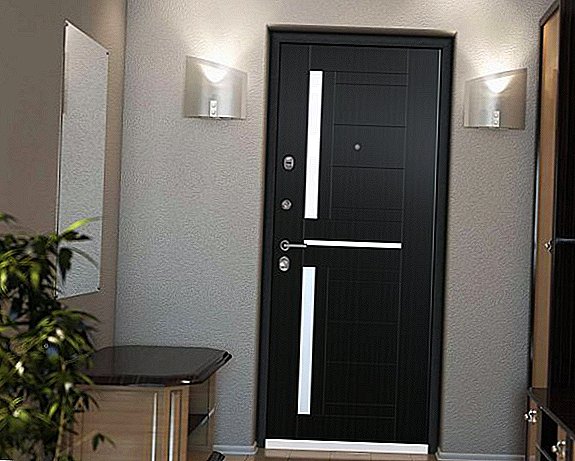 There are many men who love to do everything with their own hands, without attracting masters to it. For them, no problem and wallpaper pokleit, and lay a laminate. And what about the door trim?
There are many men who love to do everything with their own hands, without attracting masters to it. For them, no problem and wallpaper pokleit, and lay a laminate. And what about the door trim?
We think that this is also possible for them, and we want to share with them valuable advice, telling how to properly sheathe the door - iron or wood, and explain all the pros and cons of various materials for plating. About all this - below.
Than sheathe: materials
There are several options for plating:
- laminate - they are trimming walls and even ceilings, so you can also take it safely for covering the door. But experts advise to use laminate only for apartments and preferably only from the inside. Laminate is quite resistant to mechanical stress, but will not tolerate excessive moisture;

- lining - considered a universal material, it is suitable for both the apartment and for a private house, where the material will be more susceptible to precipitation. The paneling is easy to attach to the surface, and it can be painted in any color. Traditionally, it is made of cut board made of natural wood, but there is also the so-called budget option - plastic PVC lining (polyvinyl chloride), it is resistant to moisture and is not subject to rotting or corrosion. But it must be protected from direct sunlight, because it affects the appearance of the material;

- MDF board - This material is made of pressed wood fibers impregnated with synthetic resin - a pretty good option, because it is quite durable and environmentally friendly. But for a private house to choose them is not recommended. MDF plates can be painted in any color, put on them a drawing or film.

Important! Consider: the weight of the door trimmed with MDF will increase greatly, which will be an additional load on the door hinges.
- leatherette - the most cheap, simple, versatile and time-tested method. Previously, it was perhaps the most basic method of lining door panels. True, leatherette has one significant drawback - it is easy to damage (even in case of accidental contact with sharp objects).

Basics
Consider the features of the base, that is, the material from which the door is made.
In the process of repair, there are various surprises and ideas, it is useful to learn how to remove paint from walls, how to wash off whitewash, how to glue wallpaper, how to hold a plumbing in a private house, how to put an outlet, how to make a plasterboard partition with a doorway, how to put a light switch, how to install a flowing water heater, how to sheathe walls with drywall, how to install blinds.
Wooden door
To begin, let's talk about the most popular forms of it:
- Leadership here holds solid pine. And all because of the inexpensive cost of the material. True, this does not relieve him of his shortcomings: he is quite mild, does not tolerate moisture and strong temperature drops.
- Another option is a nut. This tree is also quite inexpensive. It has a beautiful structure and ornate patterns. It has many features regarding its processing.
- An alder is perfect for the front door or the door to the bathroom, as it keeps moisture well. Plus, it has a low resin content, which is important.
- The best option is, of course, oak. It is durable, strong, moisture-resistant, does not let cold and noise into the room. The surface of such a door is practically not deformed upon impact. But this stuff is the most expensive.
 The main advantages of wooden doors:
The main advantages of wooden doors:- environmental friendliness;
- with proper care, it will last more than a dozen years;
- high noise and heat insulation.
- requires more care and extreme care in operation;
- Some wood species have low moisture resistance, therefore they are not suitable for any room.
Important! Buying a wooden door, by all means contact only a trusted manufacturer! Often unscrupulous firms sell cheaper, and therefore less quality, material under the guise of expensive. To do this, they repaint the wood in the desired color. And an inexperienced buyer may simply not notice a fake.To sheathe a wooden door can be any of the above methods.

Metal (iron) door
Benefits:
- it is believed that it is more reliable (but here we should not forget about high-quality locks!);
- moisture resistance is higher than that of the wooden “fellow”;
- tolerates temperature fluctuations;
- using seals, you can get high noise and heat insulation;
- does not require special care (although it is also necessary to keep an eye on such a door).
- dents and scratches often appear on the metal door, which spoils its aesthetic appearance;
- rust may occur;
- sometimes their strength is not good, for example, during a fire at the rescuers, it will take a lot of time to open it.

How to sheathe the door
We turn directly to the trim with different materials, learn about all the features of each method.
Laminate
Step by step plating instruction:
- Remove the door from the hinges and place it on a flat surface.
- Remove all accessories - locks, handles, peephole, etc.
- Paint the wooden slats in the desired color and fasten them around the perimeter of the structure (for metal, liquid nails will be needed here).
- Assemble the shield from the laminated panels (make sure that all parts must fit as closely as possible to each other - butt-to-butt joint).
- Measure the distance between the individual rails and transfer the results to the shield.
- Saw the outer panels in length and width (this is best done with an electric jigsaw).
- Tightly process the door adhesive composition. Wait for the glue to hold, then put the shield on the canvas and press it down with something heavy.
- When the glue dries, the door can be put in place and then fastened to the hardware.
Important! Use laminate with a minimum thickness of 7-8 mm!Do not forget about the need to make slopes. They will protect your home from drafts and noise, make the door look more presentable.
The slopes make the same laminate that was used for plating. But first, eliminate all the gaps between the wall and casing assembly foam or special cement (on the basis of adhesive). If you chose foam when it dries, be sure to cut off all its excess part with a knife and only then proceed to the slopes:
- The most common method is gluing a finishing material with a solution. Such a slope will not bend, will be durable and soundproof;
- if we talk about the decorativeness of the slopes, then you can use a special textured plaster or paint. True, it is necessary to pay attention to the peculiarity of the material, for example, its possible incompatibility (the manufacturer on the package will certainly tell about it);
- another design method is frame lining with facing material. To do this, you need to make a simple "skeleton" of wooden bars and metal profiles. Then, applying universal screws (do not forget about the plugs on the screws that will match the tone to the laminate), attach the laminate to the frame - along or across. Vertical slats should be fixed at the edges and center, and horizontal - only at the edges.
If you still want to apply the laminate and for plating outside, use a special waterproof solution and anti-vandal impregnation. Proper care will extend the life of this material by far not one year.
A jack of all trades turns out to do any good thing if you wisely approach the construction of a cellar with ventilation, a sheep house, a chicken coop, a veranda, a gazebo, pergolas, a brick fence, a blind area of the house, a smokehouse of hot and cold smoking, a concrete walkway, a bath, a gable roof, a greenhouse , attic, with free time and financial support, you can do everything on your own.
Clapboard
Before you start, consider one thing: to install the wall paneling from the inside, she needs to lie in the house for at least a day so that she gets used to the microclimate.
- Treat the lamellas with an antiseptic and lacquer.
- Remove the door from the hinges, clean it, remove all accessories.
- Slat lamella by size (depending on the method of installation).
- Stuffing from the left edge. Set the first panel clearly along the edge (this can be checked by level). Attach it with finishing nails.
- Each lamella fit into the groove of the previous one, fasten in the same way. Sand the ends.
- Once again, open the product with varnish and after drying, put back the fittings.
- Return the canvas to the opening.
 If you have a metal door, here is a slightly different algorithm of actions:
If you have a metal door, here is a slightly different algorithm of actions:- If possible, remove it from the hinges, it will be more convenient to work.
- Remove fittings, clean the canvas.
- Lamellae can be fixed with klyaymer, screwed them with screws on the metal with a screwdriver.
- If you are going to warm the doors, install a batten of wooden slats. Frame secure with screws. Heat insulator (foam rubber, foam plastic) cut to size and place between the slats in the spacer. If necessary, stick the material to the surface of the canvas. Dock the lamels tightly and fasten them to the crate with finishing nails.
As a decoration of the house adjoining space one should consider a waterfall, an alpine slide, a fountain, a wattle fence, a bed of stones, a trellis, a rose garden, a mixborder, a dry stream.If you regularly use modern wood products for lining, the material will become more refractory and moisture-resistant, plus everything you can prevent its rotting in this way. All this will provide the material with a long service life - more than a dozen years.

Did you know? There are a lot of colored doors in Ireland, and this is not just. It turns out that the whole reason is ... the freedom of local people. When Victoria, Queen of the United Kingdom of Great Britain and Ireland, died in 1901, a decree was issued - as a sign of mourning, all doors must be repainted black. The Irish, protesting, painted them in all the colors of the rainbow, but not in black.
MDF board
They are installed both immediately on the surface of the door, and on the existing skin (for example, leatherette). Do not forget to remove all fittings before starting work.
- Drill holes along the perimeter of the porch (part of the sash, which closes the door frame). Step - 20 cm. Diameter - 3 mm.
- Drill a number of through holes along the perimeter of the door leaf (the pitch and diameter are the same).
- Screw the inner MDF pad, then the outer one. The length of the screw is a few millimeters less than the thickness of the web.
- Replace the fittings.
Video: how to install MDF plate on wooden doors
Leatherette
Wood sheathe dermatin in this way:
- Remove all accessories from the door, remove it, put it on a flat surface.
- Apply heat insulation from the facing side (synthetic winterizer, polyethylene foam, etc.).
- Nail and at the same time tighten leatherette, starting to work from the center of the door.
- Nail the middle row of nails (from top to bottom), well pulling leatherette. Similarly, beat the other rows - first to the left of the central row, then to the right.
- But here there is one snag - in turning up the edges. Special rollers are made on the outside of the door, which should cover the gap between the door leaf and the box. Tuck up the leatherette, then, with a slight stretch, nail it over the edge of the blade with upholstery nails. Rollers are not needed for the inside - tuck in the cloth and nail it.
- The trim looks more interesting if you stretch a decorative metal cord or a special thread between the nails. In this way it turns out to make any pattern.
Video: how to sheathe door dermantin If you treat the trim carefully, then it will last a very long time. Special care is not required. It is enough from time to time to wipe it with a damp soft cloth (it is possible with the addition of degreasing detergents).
Did you know? The highest doors are in the assembly hangar of the Kennedy Space Center, owned by NASA. There are only four of them, the height of each is 139 meters. For comparison, the statue of Liberty in New York is “only” 93 meters.As you can see, there are plenty of trim options. And among them, everyone can find what he needs. The main thing - to adhere to the work of all instructions. And also - do not forget about the care of the material, whichever of them you choose.
The better sheathe the door: reviews



















